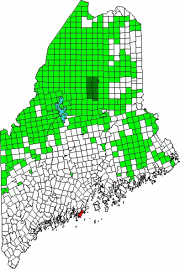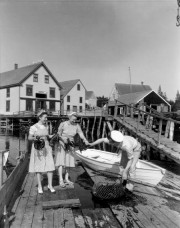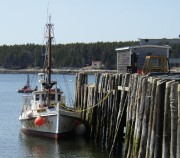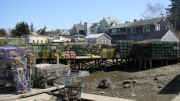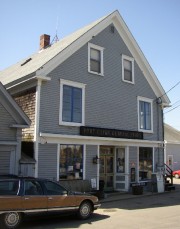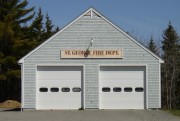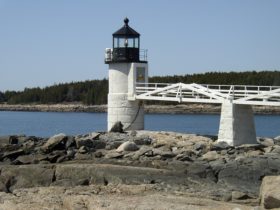Port Clyde 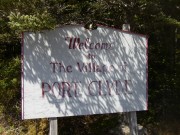 is a village in St. George at the southern tip of its long peninsular.
is a village in St. George at the southern tip of its long peninsular.
Port Clyde has long been an attraction to artists, including N. C. Wyeth, and tourists, who can take the ferry to Monhegan Island, visible in the distance. It is a base for lobster fishing and fin fishing.
The village is overwhelmingly focused on the fishing industry, with a keen eye to the summer tourist visitors.
Stacks of lobster traps in the inner harbor; a 1940’s view of Port Clyde tourism
The Brothers and Hay Ledge nature preserve occupies four islands off Port Clyde and provide a 12 acre home to a number of nesting sea birds such as the black guillemot, common eider, double-crested cormorants and various gulls.
Maine Route 131 from Thomaston runs along the eastern portion of St. George and terminates here at the Marshall Point Light Station.
Additional resources
George French photo courtesy Maine State Archives.
National Register of Historic Places – Listings
Photos, and edited text are from nominations to the National Register of Historic Places researched by Maine. Historic Preservation Commission.
Full text and photos are at https://npgallery.nps.gov/nrhp
Land’s End Historic District
In 1906 the Vermont native, Russell W. Porter, purchased 50 acres of mostly undeveloped land on Marshall Point, in Port Clyde village, town of Saint George. In the early 1890s Russell had studied art with marine painter Charles H. Woodbury and architecture at the Massachusetts Institute of Technology, received two gold medals for his Beaux Arts architectural designs and helped design an exhibit for the 1893 Columbian exposition in Chicago.
Between then and 1906 he joined no less than nine exploratory Arctic-region expeditions as artist and surveyor, including Robert E. Peary’s expedition to Greenland and others to Baffin Island, Labrador, the Yukon and the Russian Arctic. During the last he was stranded for three years after the boat was iced in. At the same time he developed his skills as an astronomer and delved into the art and science of making telescopes, skill that was to later lead to an impressive scientific career at Stellafane Observatory in Vermont and the Palomar Observatory in California. But after returning from three years on the ice Russell yearned to find a place where he could live close to nature and experience a relatively quiet, simple, and self-sustaining existence in which to nurture his creative spirit.
Within two years of purchasing the property in Port Clyde, Porter had married a local woman, divided much of his property into lots and started to pursue a vision of an enclave of seasonal residents dedicated to experiencing nature, living a simplified existence and nurturing artistic talents. Named Land’s End, Porter developed this community of “weary pilgrims” between 1906 and 1919. At Land’s End Porter built cottages (initially renting, then selling the properties), developed communal facilities and lead nature-based and art-based forays along the coast of Maine. Porter eventually built, designed or otherwise directly influenced at least 14 cottages in the colony, and created a summer community with lasting cohesion and dedication to the properties.
Unlike other colonies characterized by a specific aesthetic for their buildings (i.e. log cabins or large Shingle Style estates) the cottages at Land’s End are an eclectic mix of Craftsmanstyle, Shingle Style, Chalet and (English) Colonialrevival style buildings. The exterior design of the cottages differ, but the interiors retain a consistent degree of detailing and finishes. Several of the cottages feature repetitive themes (gables, trees, animal life) drawn from Porter’s observations both abroad and in Port Clyde, or built-in furniture and free-standing furnishings constructed by Porter using local wood.
Marshall Point Light Station
[Marshall Point, Port Clyde Harbor] The Marshall Point Light Station consists of a 1½ story gambrel roofed keeper’s house, a granite oil house and a detached round granite light tower. On a rock outcropping, the tower is connected to the shore by a wooden walkway supported by three granite piers.
The Light Station, at the eastern entrance to Port Clyde Harbor, was established in 1832 and partially rebuilt in 1857 and 1896. Port Clyde is a small coastal community along the Saint George peninsula whose 19th century economy was heavily dependent upon maritime pursuits. Its long established fishing industry was supplemented in the 1830s by local ship building enterprises that survived to the turn of the century.
Port Clyde was the site of a commercial ice industry and the home of the South Saint George Guano and Oil Corporation, both of which had their beginnings in the mid 1870s. Building on its fisheries, a canned lobster plant was founded in the 1880s. These industries relied on water borne transportation whose successful passage of the area was closely tied to the operation of the Light Station. [See additional photo above left.]



